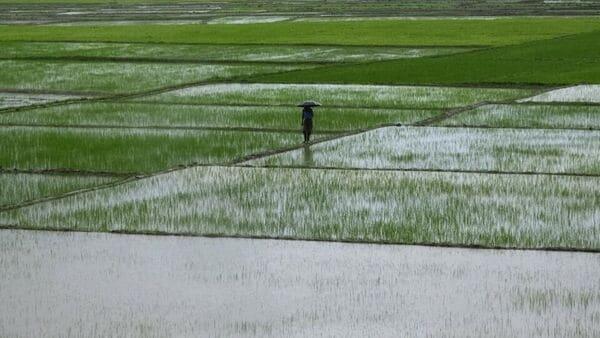
Krishi-DSS To Predict Pest Attacks, Droughts And More - Right On Farmers' Phones
The module will use advanced analytics to integrate field-level data with predictive insights, helping farmers make informed decisions, improve yields, and reduce losses, they said.
The advisories will be sent through SMS and voice calls in local languages, making them accessible even to farmers with basic feature phones.
Also Read | Why onion prices are making farmers cry this year, explained in chartsQueries sent to the agriculture ministry remained unanswered till press time.
Integrated data ecosystemKrishi-DSS is a first-of-its-kind digital geo-spatial platform designed for Indian agriculture. It brings together satellite imagery, weather data, groundwater and reservoir levels, and soil health information on one dashboard.
"There are 16 modules in Krishi-DSS. Out of these, 13 are already operational, and we hope to roll out the remaining three-the agro-forestry and horticulture modules, the farm advisory module, and the custom scripting environment-soon," said a senior official from the agriculture department.
"Among the three, the farm advisory module is very important as farmers will get customized alerts," the official added.
Data-led precision farmingOne of the existing tools, the crop mapping and monitoring module, helps the government analyse cropping patterns by studying parcel-level crop maps across years. This enables better understanding of crop rotation practices and promotes sustainable farming.
Similarly, the drought monitoring module tracks real-time indicators such as soil moisture, crop condition, and dry spells, while the Crop Weather Watch module keeps officials updated on weather impacts, harvest status, and crop residue burning.
Farmers can also access detailed soil data-including soil type, pH, and health metrics-to plan crop suitability and adopt water conservation measures.
According to the second official, the idea is to provide a holistic solution to farmers and also utilize the available information for policy formulation.
Also Read | Farmers need insurance payouts for climate setbacks without proving losses“By integrating various data sources on Krishi-DSS, multiple farmer-centric solutions can be developed, such as individualized advisories and early warnings for pest attacks, heavy rainfall, or hailstorms,” said the second official.
“It will also help the government understand cropping patterns by analysing parcel-level crop maps over different years,” the official added.
The initiative's success, however, will depend on its accessibility and usability for farmers.
"This is a commendable initiative by the agriculture ministry; however, the implementation will depend on its user-friendliness," said Puneet Singh Thind, a farmer from Ambala, Haryana.
Mobile connectivity in rural India has been steadily improving. As of 30 September, rural mobile phone density stood at 59%, with 530.27 million subscriptions across the country.
Collaboration across agenciesKrishi-DSS brings together data from multiple departments. Indian Space Research Organisation (Isro) provides satellite imagery and geospatial data on soil moisture and floods, the India Meteorological Department (IMD) supplies weather forecasts, the Soil and Land Use Survey of India (SLUSI) tracks soil health, and the Central Water Commission (CWC) monitors irrigation water resources. International remote-sensing inputs supplement real-time information on crop health and environmental conditions.
Together, these datasets enable precision farming, risk management, and sustainable practices across agroclimatic zones.
Experts say farmers also need market-linked intelligence to guide crop planning.
"There are many apps for farmers, and the field is very competitive. However, farmers continue to struggle with marketing their produce. They need a market intelligence app capable of forecasting crop prices three to four months in advance," said Ajay Vir Jakhar, chairman, Bharat Krishak Samaj.
Existing digital ecosystemIndia already has several farmer-facing digital initiatives that deliver weather and agricultural information. According to government data, around 1.8 million farmers have downloaded IMD's weather apps such as Mausam, Meghdoot, and Damini.
While IMD apps offer general weather and agro-advisories-Mausam provides comprehensive weather services, Meghdoot delivers region-specific advisories in local languages, and Damini focuses on lightning alerts-the Krishi-DSS will go a step further by providing customized, location-specific advisories based on real-time data on soil health, crop conditions, and potential risks like pests or hailstorms.
Additionally, the agriculture ministry operates the Kisan Suvidha mobile app, which provides farmers with information on weather forecasts, crop insurance, soil health cards, and government schemes. According to an agriculture official, the app currently has around one million users.
Also Read | Farmers need help: Raids on farms by wild animals are hurting their cropsPrivate players, too, have joined the ecosystem. Mahindra & Mahindra, for instance, runs Mera Swaraj and mPragati apps for its customers, offering tractor service scheduling, dealer ratings, and product information. Its Krish-e Farming Services platform provides end-to-end, app-based agronomy and advisory support, including easy access to nearby mandi prices.
Legal Disclaimer:
MENAFN provides the
information “as is” without warranty of any kind. We do not accept
any responsibility or liability for the accuracy, content, images,
videos, licenses, completeness, legality, or reliability of the information
contained in this article. If you have any complaints or copyright
issues related to this article, kindly contact the provider above.

















Comments
No comment